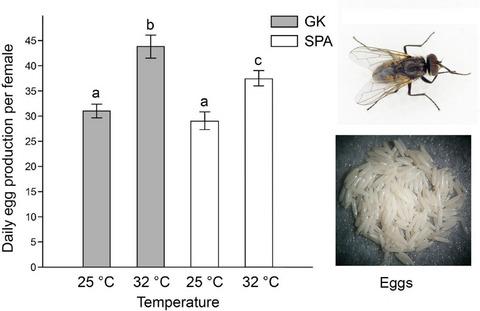当前位置:
X-MOL 学术
›
Entomol. Exp. Appl.
›
论文详情
Our official English website, www.x-mol.net, welcomes your feedback! (Note: you will need to create a separate account there.)
Effect of temperature on egg production in the common housefly
Entomologia Experimentalis et Applicata ( IF 1.9 ) Pub Date : 2020-05-13 , DOI: 10.1111/eea.12912 Ljubinka Francuski 1 , Walter Jansen 2 , Leo W. Beukeboom 1
Entomologia Experimentalis et Applicata ( IF 1.9 ) Pub Date : 2020-05-13 , DOI: 10.1111/eea.12912 Ljubinka Francuski 1 , Walter Jansen 2 , Leo W. Beukeboom 1
Affiliation

|
Musca domestica L. (Diptera: Muscidae), better known as the common housefly, is increasingly considered to be a new, alternative protein source for animal nutrition. By transferring low‐value organic side streams into high‐value protein products, its commercial production contributes to a circular economy. Next to technical innovations for scaling‐up the production capacity, efficient egg production has been identified as one of the bottlenecks of housefly production systems. We investigated egg production in two strains, one originally from Spain (SPA) and one from The Netherlands (GK), at 25 and 32 °C. At 25 °C, duration of preoviposition period, laying phase, and adult longevity was longer than at 32 °C. Lifetime egg production was lower at 32 °C, but the number of clutches laid per female was unaffected by temperature. Daily egg production at 32 °C was higher during the first 7 days, revealing a trade‐off between higher early‐in‐life reproductive effort and adult longevity. The combination of shorter sexual maturation period and higher daily egg‐laying rate resulted in reaching 50% of total egg production only 6 days after emergence at 32 °C for both strains, compared to 13 and 14 days at 25 °C for SPA and GK, respectively. We conclude that, in the absence of a need for high adult survival rates, houseflies have favourable production performances at higher temperature, and that efficacy and yield of the production process could be maximized by increasing the rearing temperature to 32 °C.
中文翻译:

温度对普通家蝇产蛋量的影响
家蝇(双翅目:蝇科),更为人所知的是普通家蝇,越来越被认为是动物营养的一种新的替代蛋白质来源。通过将低价值的有机侧流转化为高价值的蛋白质产品,其商业生产有助于循环经济。除了扩大生产能力的技术创新之外,高效的鸡蛋生产已被确定为家蝇生产系统的瓶颈之一。我们研究了两种菌株在 25 和 32 °C 下的产蛋量,一种来自西班牙 (SPA),另一种来自荷兰 (GK)。在 25 °C 时,产卵前期、产蛋期和成虫寿命的持续时间比 32 °C 时长。终生产蛋量在 32 °C 时较低,但每只雌性产卵的数量不受温度影响。在前 7 天,32 °C 下的日产蛋量较高,这表明较高的生命早期繁殖努力与成年寿命之间存在权衡。较短的性成熟期和较高的每日产卵率相结合,导致两种菌株在 32°C 下出苗后仅 6 天就达到总产蛋量的 50%,而 SPA 和 GK 在 25°C 下为 13 和 14 天, 分别。我们得出的结论是,在不需要高成虫存活率的情况下,家蝇在较高温度下具有良好的生产性能,并且通过将饲养温度提高到 32°C 可以最大限度地提高生产过程的效率和产量。较短的性成熟期和较高的每日产卵率相结合,导致两种菌株在 32°C 下出苗后仅 6 天就达到总产蛋量的 50%,而 SPA 和 GK 在 25°C 下为 13 天和 14 天, 分别。我们得出的结论是,在不需要高成虫存活率的情况下,家蝇在较高温度下具有良好的生产性能,并且通过将饲养温度提高到 32°C 可以最大限度地提高生产过程的效率和产量。较短的性成熟期和较高的每日产卵率相结合,导致两种菌株在 32°C 下出苗后仅 6 天就达到总产蛋量的 50%,而 SPA 和 GK 在 25°C 下为 13 和 14 天, 分别。我们得出的结论是,在不需要高成虫存活率的情况下,家蝇在较高温度下具有良好的生产性能,并且通过将饲养温度提高到 32°C 可以最大限度地提高生产过程的效率和产量。
更新日期:2020-05-13
中文翻译:

温度对普通家蝇产蛋量的影响
家蝇(双翅目:蝇科),更为人所知的是普通家蝇,越来越被认为是动物营养的一种新的替代蛋白质来源。通过将低价值的有机侧流转化为高价值的蛋白质产品,其商业生产有助于循环经济。除了扩大生产能力的技术创新之外,高效的鸡蛋生产已被确定为家蝇生产系统的瓶颈之一。我们研究了两种菌株在 25 和 32 °C 下的产蛋量,一种来自西班牙 (SPA),另一种来自荷兰 (GK)。在 25 °C 时,产卵前期、产蛋期和成虫寿命的持续时间比 32 °C 时长。终生产蛋量在 32 °C 时较低,但每只雌性产卵的数量不受温度影响。在前 7 天,32 °C 下的日产蛋量较高,这表明较高的生命早期繁殖努力与成年寿命之间存在权衡。较短的性成熟期和较高的每日产卵率相结合,导致两种菌株在 32°C 下出苗后仅 6 天就达到总产蛋量的 50%,而 SPA 和 GK 在 25°C 下为 13 和 14 天, 分别。我们得出的结论是,在不需要高成虫存活率的情况下,家蝇在较高温度下具有良好的生产性能,并且通过将饲养温度提高到 32°C 可以最大限度地提高生产过程的效率和产量。较短的性成熟期和较高的每日产卵率相结合,导致两种菌株在 32°C 下出苗后仅 6 天就达到总产蛋量的 50%,而 SPA 和 GK 在 25°C 下为 13 天和 14 天, 分别。我们得出的结论是,在不需要高成虫存活率的情况下,家蝇在较高温度下具有良好的生产性能,并且通过将饲养温度提高到 32°C 可以最大限度地提高生产过程的效率和产量。较短的性成熟期和较高的每日产卵率相结合,导致两种菌株在 32°C 下出苗后仅 6 天就达到总产蛋量的 50%,而 SPA 和 GK 在 25°C 下为 13 和 14 天, 分别。我们得出的结论是,在不需要高成虫存活率的情况下,家蝇在较高温度下具有良好的生产性能,并且通过将饲养温度提高到 32°C 可以最大限度地提高生产过程的效率和产量。



























 京公网安备 11010802027423号
京公网安备 11010802027423号